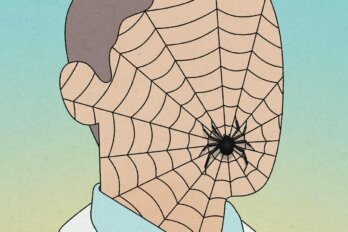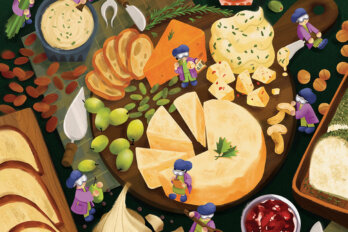Listen to an audio version of this story
For more audio from The Walrus, subscribe to AMI-audio podcasts on iTunes.
Ruby and her two brothers, Finn and Clark, used to be busy kids. Before COVID-19, their weeks were filled with soccer games, swimming lessons, trips to the park, and after-school playdates—sometimes up to five each week. To say that the transition into isolation was tough on them would be generous, according to their parents, Jessica Smith and Mark Bonta. They try not to talk about the pandemic in front of their children but have promised them that they’ll soon be able to visit other people’s houses and go into stores and have birthday parties again. Still, despite their best efforts, they’ve noticed that their kids have started exhibiting some unusual behaviours.
Clark—who, at two years old, has spent three-quarters of his life in the pandemic—gets easily overwhelmed by the bright lights and strangers at the grocery store. And, in January, the two older children, ages four and six, who had always been fairly independent, started sporadically sleeping in the same bed. The first time their parents found them curled up together under Finn’s Super Mario Brothers blanket, they asked Ruby why she wasn’t in her own bed. “I just needed to touch another human,” she answered.
Touch is an important sense. Our skin has a complex system of nerve endings and touch receptors that direct signals to our brains in order to let us know that, yes, this is soft, this is warm, this is familiar. Touch helps us bond with others. It’s a big part of how we communicate. But, over the past fifteen months, we’ve taught kids to avoid contact of all kinds: they are not to touch things at the store or the park, and they’re definitely not to touch other people—not just to keep their hands off but to keep away entirely, maintaining a two-metre buffer zone whenever possible.
If you’re over the age of twenty-five, a year without many hugs, high-fives, or handshakes won’t stunt your social growth since your brain has already done the majority of its hardwiring. But that’s not the case for kids like Ruby, Finn, and Clark, who are still in the crucial stages of their development.
In a report published by North Dakota State University, Sean Brotherson, a professor in the Human Development and Family Science Department, wrote that a combination of primary and secondary attachments is ideal for healthy social development. Primary attachments—the relationships between children and caregivers—are formed during the first two to three years of life. By the age of four, children begin to connect with others; most have a best friend and can tell you whether they like or dislike certain people. These early relationships lay the foundations of basic social skills like empathy, conflict resolution, regulating emotions, and active listening.
Primary and secondary attachments are, ideally, secure, meaning the child feels safe to explore their surroundings without a constant need for reassurance. But a year of school closures and haphazard reopenings has created a shaky foundation for many kids, and when too much focus is placed on a single attachment, there’s a risk of overreliance. In the most extreme scenario, the child may develop separation anxiety and have difficulty functioning independently. With the formation of these essential attachments disrupted, it’s possible that an entire cohort of pandemic kids are reentering the world without the basic social skills they need to navigate day-to-day life. Now, researchers are trying to understand the extent of the damage and whether the effects will persist into adulthood.
Guanghai Wang, who works in the Department of Developmental and Behavioral Pediatrics at the Shanghai Children’s Medical Center, says that, while most of us have felt the effects of social isolation, it has likely taken the greatest toll on children. Last March, Wang and a team of researchers published a paper in The Lancet reviewing the small body of research that has been conducted on the effects of home confinement on kids during COVID-19. They noted that a lack of in-person contact with classmates, friends, and teachers could likely have negative consequences, such as poor mental and physical health. In another study, children subjected to quarantine during past epidemics showed post-traumatic stress scores up to four times higher than those who did not have to isolate. That stress, coupled with the abrupt shift in routine, can resurface in the form of mental health problems, including anxiety and depression.
“Once these changes become habituated, the children may start showing more withdrawn behaviours and less interests in social activities and engagements,” says Wang, adding that this could lead to continued social isolation even after lockdowns end.
Social difficulties aren’t the only issues kids are expected to encounter in a post-COVID-19 world. Since these skills are interconnected with cognitive abilities, a lack of interaction with others can impact things like speech and reasoning, leading to poorer academic performance later on.
Smith and Bonta have already observed these types of struggles in six-year-old Finn. They had him assessed in January and found that his reading was well below where it should be for his age. “He essentially missed a full grade of school,” says Smith. Finn hadn’t taken easily to online learning, so the news didn’t come as much of a surprise. As for their youngest son, Clark, they’ve noticed that his speech is further behind where his siblings were at his age. “It certainly crossed our mind that he’s only gone to daycare when people have worn full PPE and masks, and the people that are educating and teaching him, he can’t see their faces,” says Smith. “I’m sure that has contributed.”
This lag in development makes sense. Babies initially learn to communicate through eye contact, but between four and eight months, their focus shifts to the mouth. Once they begin to make sounds, they start lip-reading to mimic shapes, syllables, and eventually words. Both eye contact and lip-reading are important parts of early communication, so if half of a person’s face is covered by a mask, learning how to speak becomes much more difficult. When kids like Clark fall behind, it can be hard to catch up.
Hirofumi Morishita, an associate professor of psychiatry at Mount Sinai’s Icahn School of Medicine, in New York, has spent the past fifteen years studying what’s called the “critical period” in development. During this period, which includes those early attachment-forming years and lasts throughout childhood, the brain learns all the fundamentals: how to move, how to talk, how to manage emotions, and how to socialize. Last August, to see how isolation might affect brain function throughout part of that critical period, Morishita and his team conducted studies on growing mice. The mice were placed alone in a cage and given enough food and water to survive for two weeks. (Mice are considered to be adults in about two months, so two weeks is a significant portion of their youth.) Once the isolation period was up, they were immediately reintroduced to other mice. Morishita found that the mice who had been in isolation were less likely to approach other mice for social interaction, while those who were isolated at later stages of their lives did not exhibit the same behaviour. The explanation, he says, is a problem within the brain. During their analysis of the isolated mice, the researchers noticed damage in a part of the prefrontal cortex that is responsible for social function.
“This tells you it’s a sensitive period,” says Morishita. “There is something special about this social experience early in life . . . . I think that gives us some insight into how this shutdown has impacted kids more profoundly than us.”
The study will not go to human trials, but Morishita speculates that the reintegration period after isolation could be key. “How kids spend their time after isolation may be equally important as time during isolation,” he says, adding that, while we’re all excited to get back to our lives, we should carefully monitor how kids are responding.
As an example, Morishita spoke of his five-year-old son. In March, he was going into and out of preschool as restrictions in New York fluctuated, and he would get “super excited” when he was back in school because the only people he saw in-person outside of that setting were his parents. But, Morishita says, a gradual reintegration is important since kids may feel overwhelmed by too much at once—kind of like a sugar high followed by the inevitable crash. Changes in behaviour—like trouble communicating, poor sleep patterns, sudden mood swings, and difficulty following rules—can be good indicators of how well kids are adjusting.
In a recent Globe and Mail article, Peter Szatmari, chief of the Toronto-based Child and Youth Mental Health Collaborative, between the Centre for Addiction and Mental Health, the Hospital for Sick Children, and the University of Toronto, encouraged parents to gradually introduce independence to their kids, whether by letting them spend more time alone in the backyard or letting them go for a solo walk down the street. For those who continue to struggle, Wang recommends therapy, either virtual or in person.
As vaccines roll out in Canada, we are starting to get an idea of when life could return to “normal” and what that normal may look like. In May, Canada’s chief public health officer, Theresa Tam, said that provinces can begin to adjust their plans for reopening once 75 percent of adults have received one vaccine dose and 20 percent have had both doses—likely around September. While a gradual reopening over the coming months may be slower than some would prefer, it’s a pace that gives children time to adjust.
Smith and Bonta have noticed eagerness in their own kids to return to their busy lives. Ruby often asks when she can see her friends inside again, and Finn asks why he can’t go into stores. Right now, Smith just tells them that these things have to wait. So, until “normal” comes, Ruby and Finn will continue to occasionally share a bed because, after being told for months on end to stay away, it’s nice to touch another human.



